Analysis of Australian Family Law and Child Welfare Legislation
VerifiedAdded on 2022/10/11
|6
|2069
|42
Essay
AI Summary
This essay provides an analysis of the Australian Family Law Act 1975, examining its provisions concerning family and child welfare. It delves into the Act's historical context, including amendments and the division of influence between the Commonwealth and the states. The essay highlights key aspects such as parental responsibilities, court powers in family matters, and the importance of child welfare. It discusses the limitations of the Act and how courts address issues in non-traditional families. The essay also explores parenting plans and the Act's principles regarding financial support and parental duties, ultimately concluding that the Act aims to safeguard the welfare of families and children by defining rights, duties, and responsibilities.
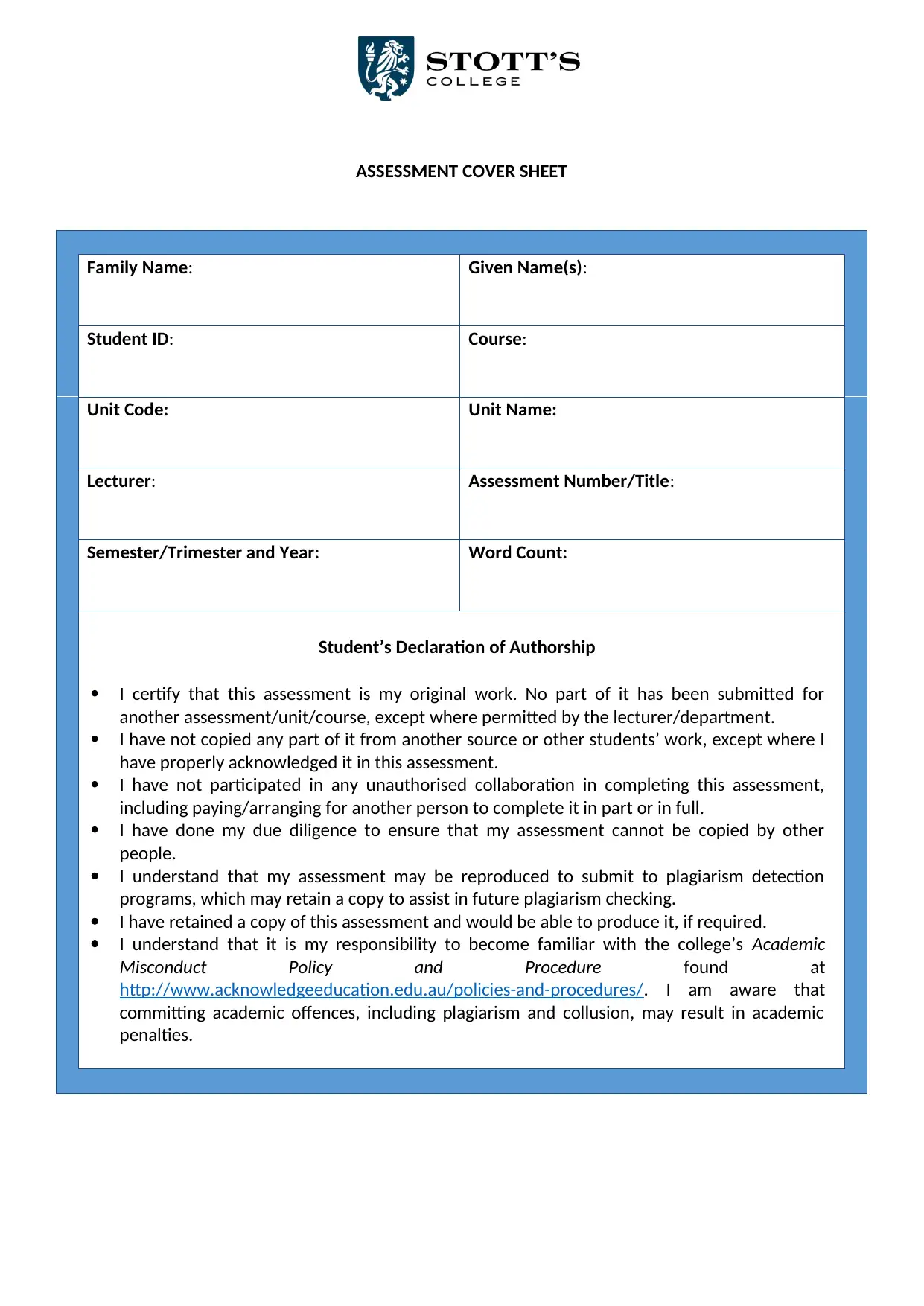
ASSESSMENT COVER SHEET
Family Name: Given Name(s):
Student ID: Course:
Unit Code: Unit Name:
Lecturer: Assessment Number/Title:
Semester/Trimester and Year: Word Count:
Student’s Declaration of Authorship
I certify that this assessment is my original work. No part of it has been submitted for
another assessment/unit/course, except where permitted by the lecturer/department.
I have not copied any part of it from another source or other students’ work, except where I
have properly acknowledged it in this assessment.
I have not participated in any unauthorised collaboration in completing this assessment,
including paying/arranging for another person to complete it in part or in full.
I have done my due diligence to ensure that my assessment cannot be copied by other
people.
I understand that my assessment may be reproduced to submit to plagiarism detection
programs, which may retain a copy to assist in future plagiarism checking.
I have retained a copy of this assessment and would be able to produce it, if required.
I understand that it is my responsibility to become familiar with the college’s Academic
Misconduct Policy and Procedure found at
http://www.acknowledgeeducation.edu.au/policies-and-procedures/. I am aware that
committing academic offences, including plagiarism and collusion, may result in academic
penalties.
Family Name: Given Name(s):
Student ID: Course:
Unit Code: Unit Name:
Lecturer: Assessment Number/Title:
Semester/Trimester and Year: Word Count:
Student’s Declaration of Authorship
I certify that this assessment is my original work. No part of it has been submitted for
another assessment/unit/course, except where permitted by the lecturer/department.
I have not copied any part of it from another source or other students’ work, except where I
have properly acknowledged it in this assessment.
I have not participated in any unauthorised collaboration in completing this assessment,
including paying/arranging for another person to complete it in part or in full.
I have done my due diligence to ensure that my assessment cannot be copied by other
people.
I understand that my assessment may be reproduced to submit to plagiarism detection
programs, which may retain a copy to assist in future plagiarism checking.
I have retained a copy of this assessment and would be able to produce it, if required.
I understand that it is my responsibility to become familiar with the college’s Academic
Misconduct Policy and Procedure found at
http://www.acknowledgeeducation.edu.au/policies-and-procedures/. I am aware that
committing academic offences, including plagiarism and collusion, may result in academic
penalties.
Paraphrase This Document
Need a fresh take? Get an instant paraphrase of this document with our AI Paraphraser
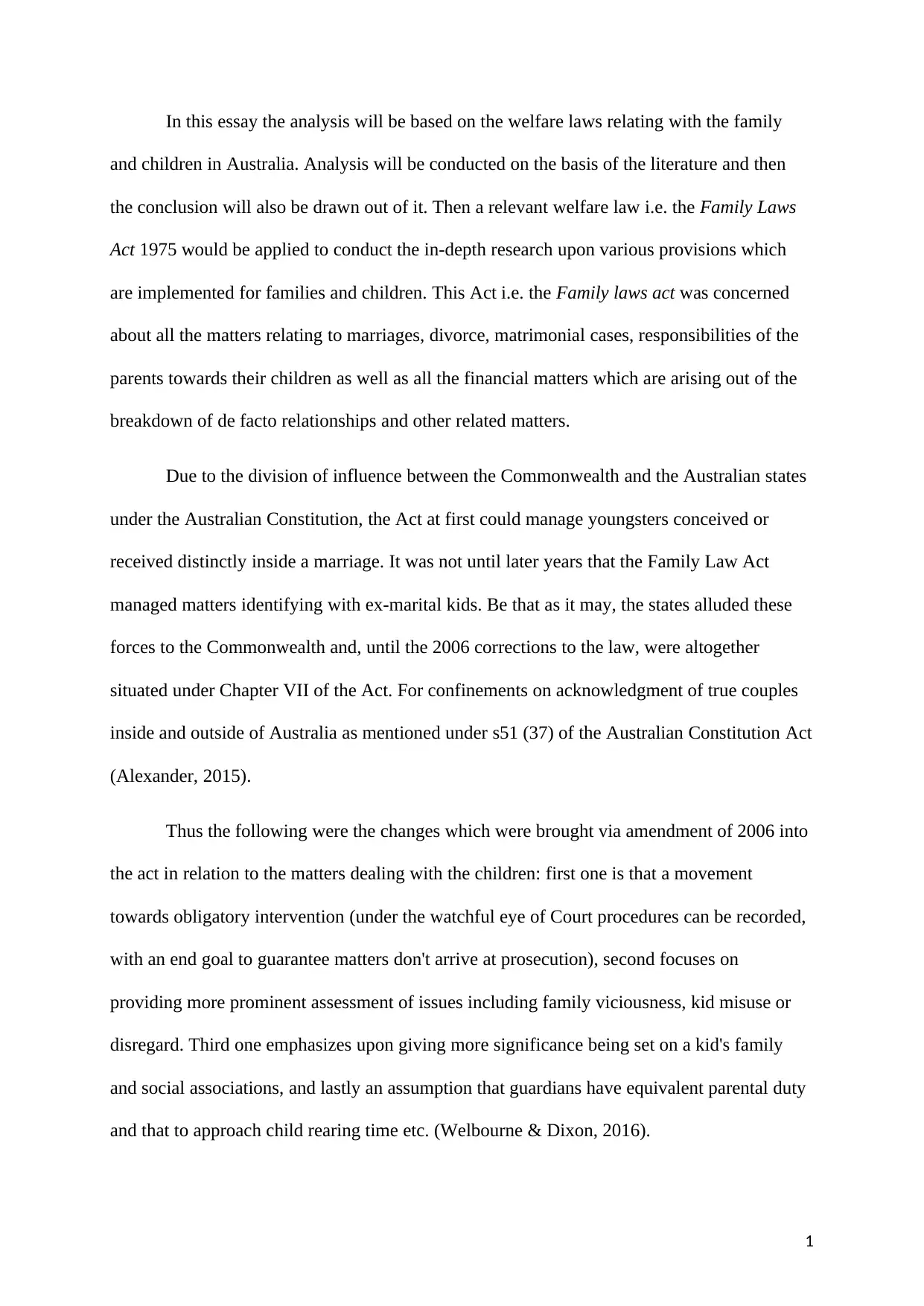
In this essay the analysis will be based on the welfare laws relating with the family
and children in Australia. Analysis will be conducted on the basis of the literature and then
the conclusion will also be drawn out of it. Then a relevant welfare law i.e. the Family Laws
Act 1975 would be applied to conduct the in-depth research upon various provisions which
are implemented for families and children. This Act i.e. the Family laws act was concerned
about all the matters relating to marriages, divorce, matrimonial cases, responsibilities of the
parents towards their children as well as all the financial matters which are arising out of the
breakdown of de facto relationships and other related matters.
Due to the division of influence between the Commonwealth and the Australian states
under the Australian Constitution, the Act at first could manage youngsters conceived or
received distinctly inside a marriage. It was not until later years that the Family Law Act
managed matters identifying with ex-marital kids. Be that as it may, the states alluded these
forces to the Commonwealth and, until the 2006 corrections to the law, were altogether
situated under Chapter VII of the Act. For confinements on acknowledgment of true couples
inside and outside of Australia as mentioned under s51 (37) of the Australian Constitution Act
(Alexander, 2015).
Thus the following were the changes which were brought via amendment of 2006 into
the act in relation to the matters dealing with the children: first one is that a movement
towards obligatory intervention (under the watchful eye of Court procedures can be recorded,
with an end goal to guarantee matters don't arrive at prosecution), second focuses on
providing more prominent assessment of issues including family viciousness, kid misuse or
disregard. Third one emphasizes upon giving more significance being set on a kid's family
and social associations, and lastly an assumption that guardians have equivalent parental duty
and that to approach child rearing time etc. (Welbourne & Dixon, 2016).
1
and children in Australia. Analysis will be conducted on the basis of the literature and then
the conclusion will also be drawn out of it. Then a relevant welfare law i.e. the Family Laws
Act 1975 would be applied to conduct the in-depth research upon various provisions which
are implemented for families and children. This Act i.e. the Family laws act was concerned
about all the matters relating to marriages, divorce, matrimonial cases, responsibilities of the
parents towards their children as well as all the financial matters which are arising out of the
breakdown of de facto relationships and other related matters.
Due to the division of influence between the Commonwealth and the Australian states
under the Australian Constitution, the Act at first could manage youngsters conceived or
received distinctly inside a marriage. It was not until later years that the Family Law Act
managed matters identifying with ex-marital kids. Be that as it may, the states alluded these
forces to the Commonwealth and, until the 2006 corrections to the law, were altogether
situated under Chapter VII of the Act. For confinements on acknowledgment of true couples
inside and outside of Australia as mentioned under s51 (37) of the Australian Constitution Act
(Alexander, 2015).
Thus the following were the changes which were brought via amendment of 2006 into
the act in relation to the matters dealing with the children: first one is that a movement
towards obligatory intervention (under the watchful eye of Court procedures can be recorded,
with an end goal to guarantee matters don't arrive at prosecution), second focuses on
providing more prominent assessment of issues including family viciousness, kid misuse or
disregard. Third one emphasizes upon giving more significance being set on a kid's family
and social associations, and lastly an assumption that guardians have equivalent parental duty
and that to approach child rearing time etc. (Welbourne & Dixon, 2016).
1
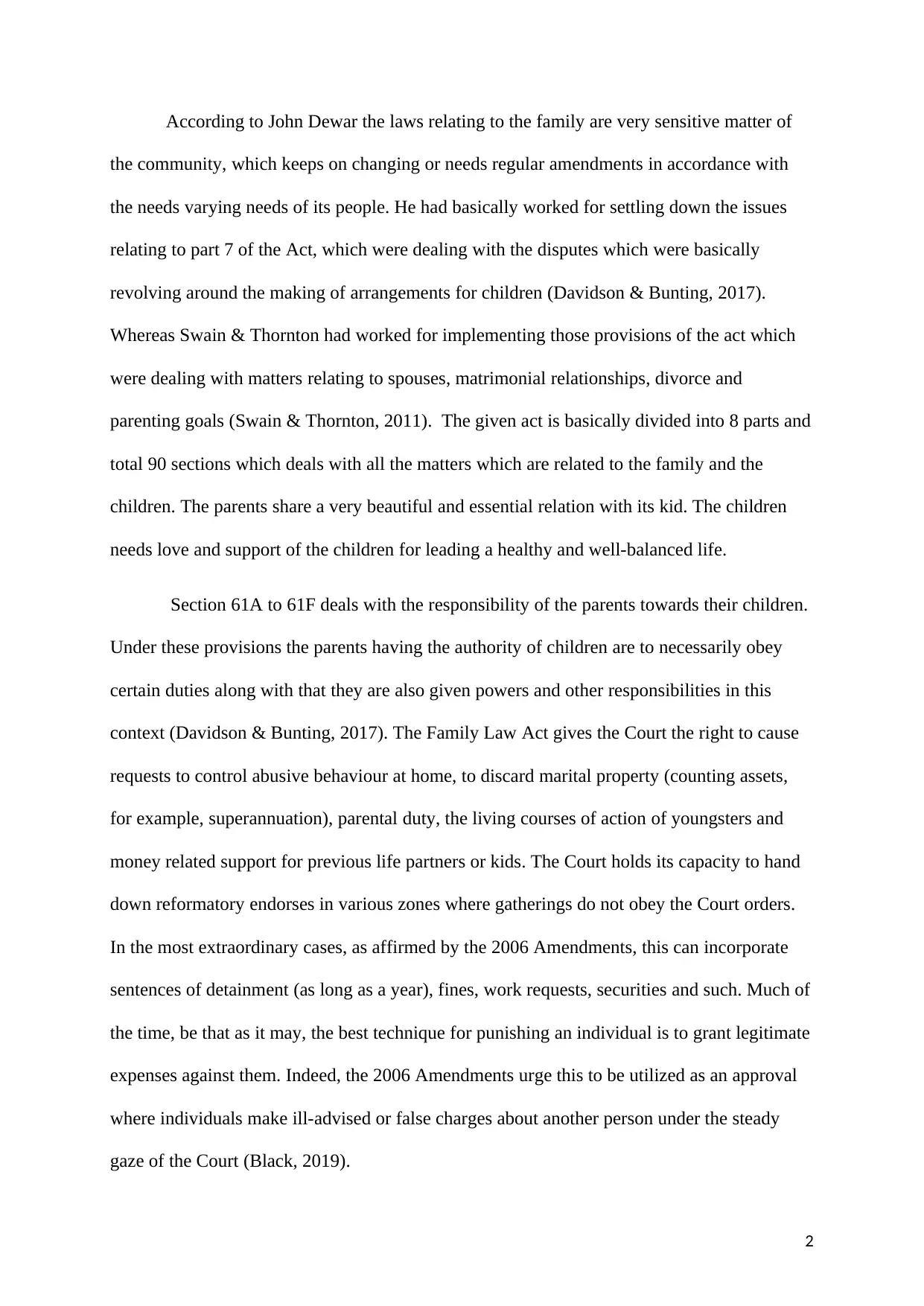
According to John Dewar the laws relating to the family are very sensitive matter of
the community, which keeps on changing or needs regular amendments in accordance with
the needs varying needs of its people. He had basically worked for settling down the issues
relating to part 7 of the Act, which were dealing with the disputes which were basically
revolving around the making of arrangements for children (Davidson & Bunting, 2017).
Whereas Swain & Thornton had worked for implementing those provisions of the act which
were dealing with matters relating to spouses, matrimonial relationships, divorce and
parenting goals (Swain & Thornton, 2011). The given act is basically divided into 8 parts and
total 90 sections which deals with all the matters which are related to the family and the
children. The parents share a very beautiful and essential relation with its kid. The children
needs love and support of the children for leading a healthy and well-balanced life.
Section 61A to 61F deals with the responsibility of the parents towards their children.
Under these provisions the parents having the authority of children are to necessarily obey
certain duties along with that they are also given powers and other responsibilities in this
context (Davidson & Bunting, 2017). The Family Law Act gives the Court the right to cause
requests to control abusive behaviour at home, to discard marital property (counting assets,
for example, superannuation), parental duty, the living courses of action of youngsters and
money related support for previous life partners or kids. The Court holds its capacity to hand
down reformatory endorses in various zones where gatherings do not obey the Court orders.
In the most extraordinary cases, as affirmed by the 2006 Amendments, this can incorporate
sentences of detainment (as long as a year), fines, work requests, securities and such. Much of
the time, be that as it may, the best technique for punishing an individual is to grant legitimate
expenses against them. Indeed, the 2006 Amendments urge this to be utilized as an approval
where individuals make ill-advised or false charges about another person under the steady
gaze of the Court (Black, 2019).
2
the community, which keeps on changing or needs regular amendments in accordance with
the needs varying needs of its people. He had basically worked for settling down the issues
relating to part 7 of the Act, which were dealing with the disputes which were basically
revolving around the making of arrangements for children (Davidson & Bunting, 2017).
Whereas Swain & Thornton had worked for implementing those provisions of the act which
were dealing with matters relating to spouses, matrimonial relationships, divorce and
parenting goals (Swain & Thornton, 2011). The given act is basically divided into 8 parts and
total 90 sections which deals with all the matters which are related to the family and the
children. The parents share a very beautiful and essential relation with its kid. The children
needs love and support of the children for leading a healthy and well-balanced life.
Section 61A to 61F deals with the responsibility of the parents towards their children.
Under these provisions the parents having the authority of children are to necessarily obey
certain duties along with that they are also given powers and other responsibilities in this
context (Davidson & Bunting, 2017). The Family Law Act gives the Court the right to cause
requests to control abusive behaviour at home, to discard marital property (counting assets,
for example, superannuation), parental duty, the living courses of action of youngsters and
money related support for previous life partners or kids. The Court holds its capacity to hand
down reformatory endorses in various zones where gatherings do not obey the Court orders.
In the most extraordinary cases, as affirmed by the 2006 Amendments, this can incorporate
sentences of detainment (as long as a year), fines, work requests, securities and such. Much of
the time, be that as it may, the best technique for punishing an individual is to grant legitimate
expenses against them. Indeed, the 2006 Amendments urge this to be utilized as an approval
where individuals make ill-advised or false charges about another person under the steady
gaze of the Court (Black, 2019).
2
⊘ This is a preview!⊘
Do you want full access?
Subscribe today to unlock all pages.

Trusted by 1+ million students worldwide
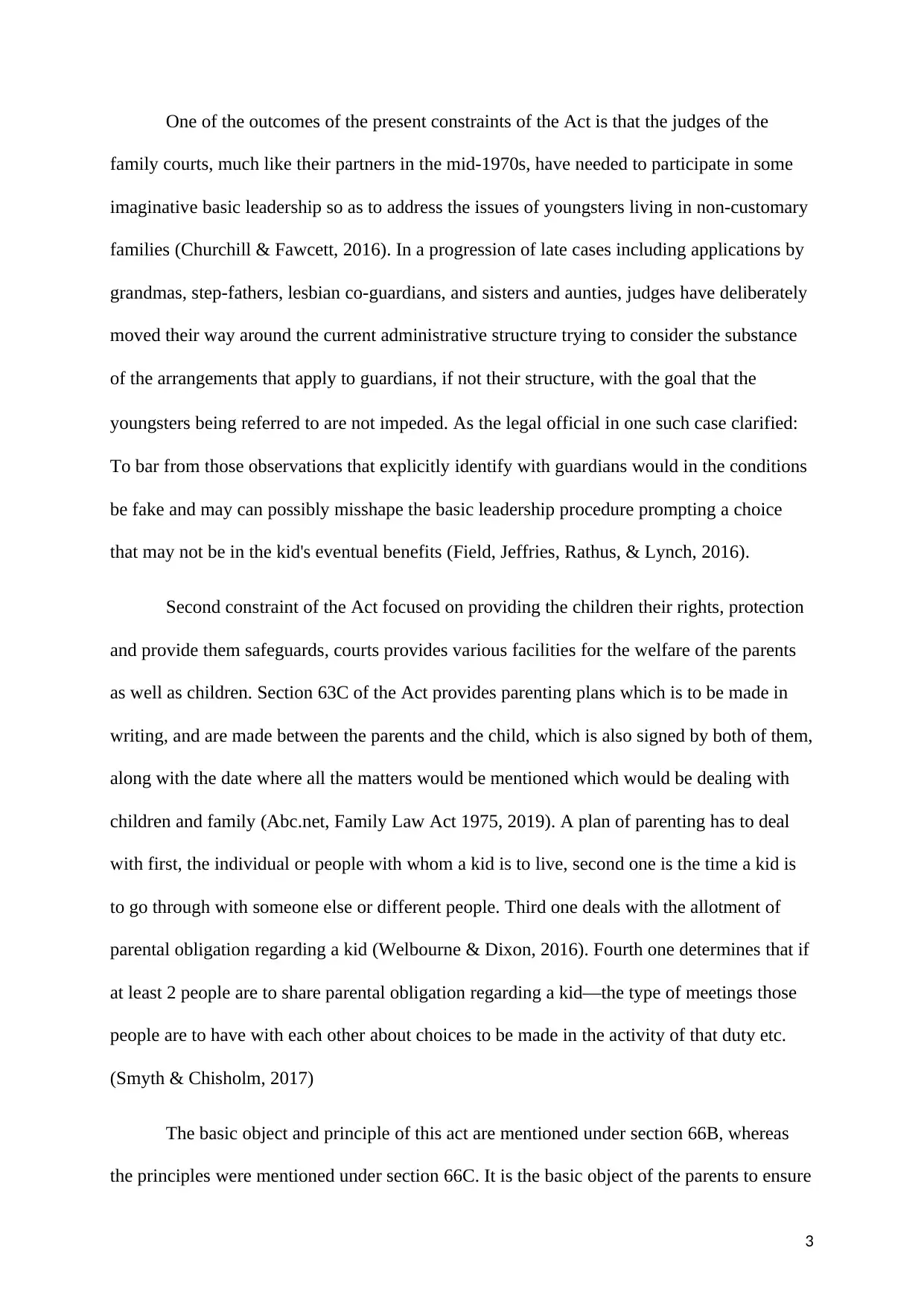
One of the outcomes of the present constraints of the Act is that the judges of the
family courts, much like their partners in the mid-1970s, have needed to participate in some
imaginative basic leadership so as to address the issues of youngsters living in non-customary
families (Churchill & Fawcett, 2016). In a progression of late cases including applications by
grandmas, step-fathers, lesbian co-guardians, and sisters and aunties, judges have deliberately
moved their way around the current administrative structure trying to consider the substance
of the arrangements that apply to guardians, if not their structure, with the goal that the
youngsters being referred to are not impeded. As the legal official in one such case clarified:
To bar from those observations that explicitly identify with guardians would in the conditions
be fake and may can possibly misshape the basic leadership procedure prompting a choice
that may not be in the kid's eventual benefits (Field, Jeffries, Rathus, & Lynch, 2016).
Second constraint of the Act focused on providing the children their rights, protection
and provide them safeguards, courts provides various facilities for the welfare of the parents
as well as children. Section 63C of the Act provides parenting plans which is to be made in
writing, and are made between the parents and the child, which is also signed by both of them,
along with the date where all the matters would be mentioned which would be dealing with
children and family (Abc.net, Family Law Act 1975, 2019). A plan of parenting has to deal
with first, the individual or people with whom a kid is to live, second one is the time a kid is
to go through with someone else or different people. Third one deals with the allotment of
parental obligation regarding a kid (Welbourne & Dixon, 2016). Fourth one determines that if
at least 2 people are to share parental obligation regarding a kid—the type of meetings those
people are to have with each other about choices to be made in the activity of that duty etc.
(Smyth & Chisholm, 2017)
The basic object and principle of this act are mentioned under section 66B, whereas
the principles were mentioned under section 66C. It is the basic object of the parents to ensure
3
family courts, much like their partners in the mid-1970s, have needed to participate in some
imaginative basic leadership so as to address the issues of youngsters living in non-customary
families (Churchill & Fawcett, 2016). In a progression of late cases including applications by
grandmas, step-fathers, lesbian co-guardians, and sisters and aunties, judges have deliberately
moved their way around the current administrative structure trying to consider the substance
of the arrangements that apply to guardians, if not their structure, with the goal that the
youngsters being referred to are not impeded. As the legal official in one such case clarified:
To bar from those observations that explicitly identify with guardians would in the conditions
be fake and may can possibly misshape the basic leadership procedure prompting a choice
that may not be in the kid's eventual benefits (Field, Jeffries, Rathus, & Lynch, 2016).
Second constraint of the Act focused on providing the children their rights, protection
and provide them safeguards, courts provides various facilities for the welfare of the parents
as well as children. Section 63C of the Act provides parenting plans which is to be made in
writing, and are made between the parents and the child, which is also signed by both of them,
along with the date where all the matters would be mentioned which would be dealing with
children and family (Abc.net, Family Law Act 1975, 2019). A plan of parenting has to deal
with first, the individual or people with whom a kid is to live, second one is the time a kid is
to go through with someone else or different people. Third one deals with the allotment of
parental obligation regarding a kid (Welbourne & Dixon, 2016). Fourth one determines that if
at least 2 people are to share parental obligation regarding a kid—the type of meetings those
people are to have with each other about choices to be made in the activity of that duty etc.
(Smyth & Chisholm, 2017)
The basic object and principle of this act are mentioned under section 66B, whereas
the principles were mentioned under section 66C. It is the basic object of the parents to ensure
3
Paraphrase This Document
Need a fresh take? Get an instant paraphrase of this document with our AI Paraphraser
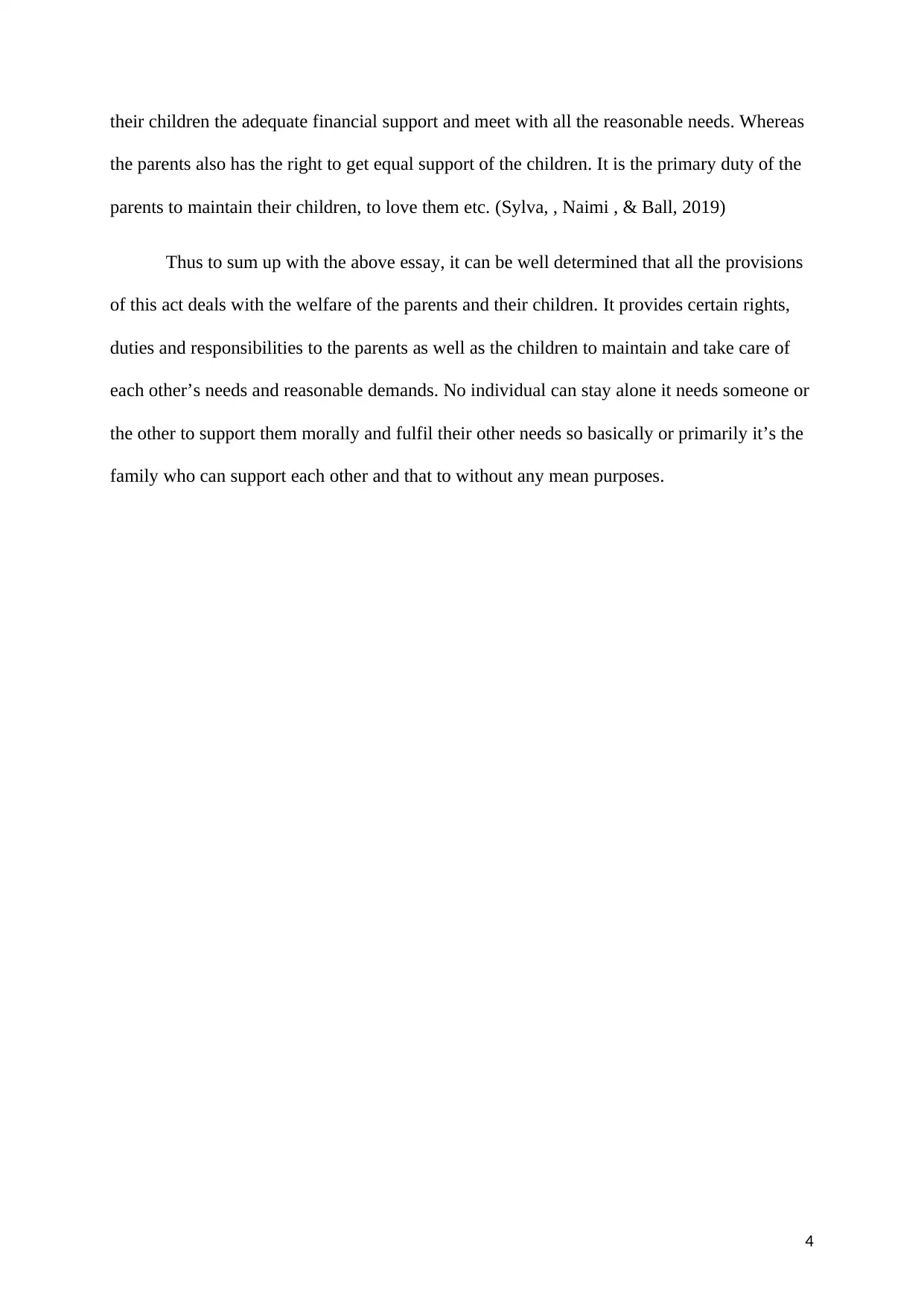
their children the adequate financial support and meet with all the reasonable needs. Whereas
the parents also has the right to get equal support of the children. It is the primary duty of the
parents to maintain their children, to love them etc. (Sylva, , Naimi , & Ball, 2019)
Thus to sum up with the above essay, it can be well determined that all the provisions
of this act deals with the welfare of the parents and their children. It provides certain rights,
duties and responsibilities to the parents as well as the children to maintain and take care of
each other’s needs and reasonable demands. No individual can stay alone it needs someone or
the other to support them morally and fulfil their other needs so basically or primarily it’s the
family who can support each other and that to without any mean purposes.
4
the parents also has the right to get equal support of the children. It is the primary duty of the
parents to maintain their children, to love them etc. (Sylva, , Naimi , & Ball, 2019)
Thus to sum up with the above essay, it can be well determined that all the provisions
of this act deals with the welfare of the parents and their children. It provides certain rights,
duties and responsibilities to the parents as well as the children to maintain and take care of
each other’s needs and reasonable demands. No individual can stay alone it needs someone or
the other to support them morally and fulfil their other needs so basically or primarily it’s the
family who can support each other and that to without any mean purposes.
4
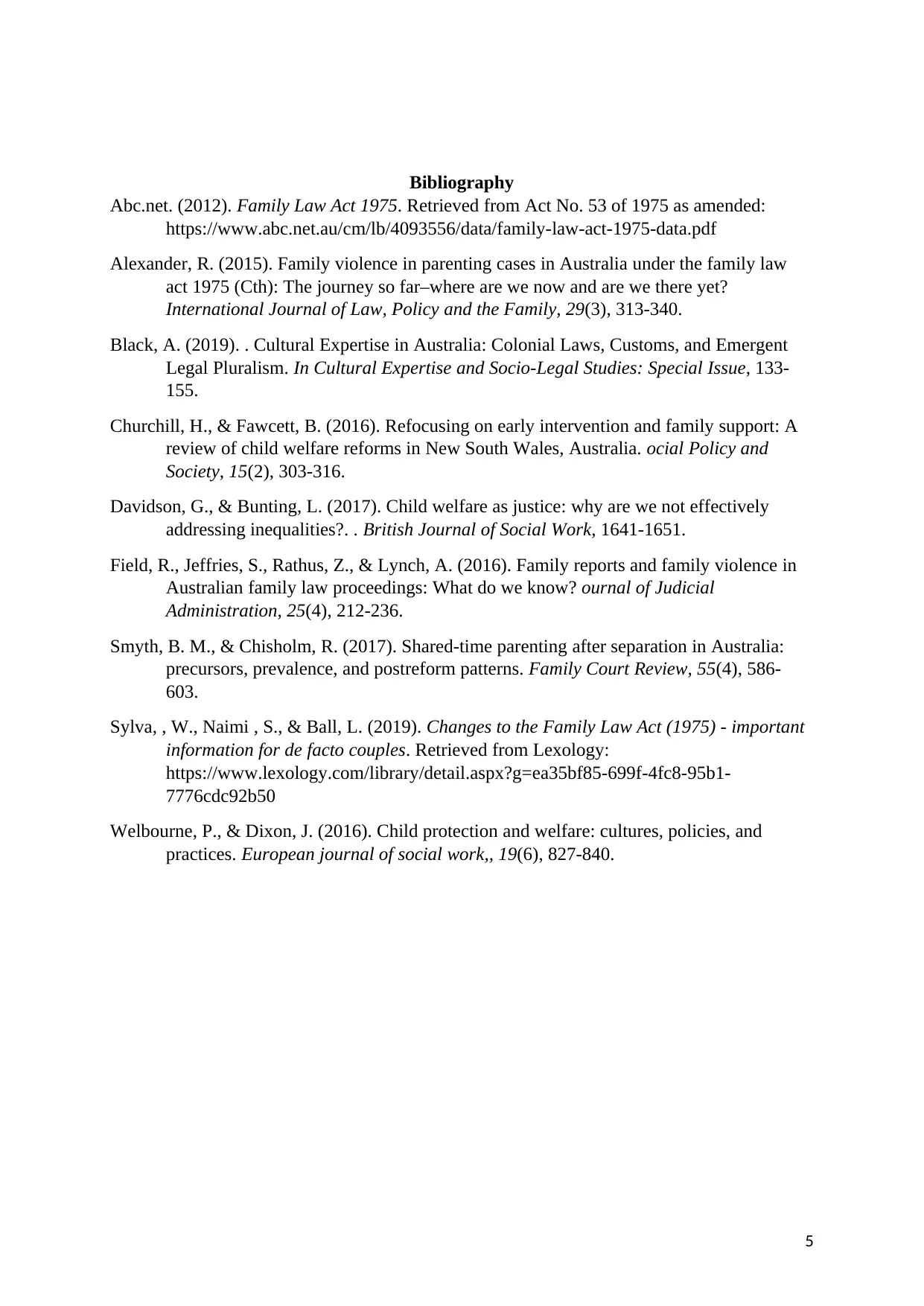
Bibliography
Abc.net. (2012). Family Law Act 1975. Retrieved from Act No. 53 of 1975 as amended:
https://www.abc.net.au/cm/lb/4093556/data/family-law-act-1975-data.pdf
Alexander, R. (2015). Family violence in parenting cases in Australia under the family law
act 1975 (Cth): The journey so far–where are we now and are we there yet?
International Journal of Law, Policy and the Family, 29(3), 313-340.
Black, A. (2019). . Cultural Expertise in Australia: Colonial Laws, Customs, and Emergent
Legal Pluralism. In Cultural Expertise and Socio-Legal Studies: Special Issue, 133-
155.
Churchill, H., & Fawcett, B. (2016). Refocusing on early intervention and family support: A
review of child welfare reforms in New South Wales, Australia. ocial Policy and
Society, 15(2), 303-316.
Davidson, G., & Bunting, L. (2017). Child welfare as justice: why are we not effectively
addressing inequalities?. . British Journal of Social Work, 1641-1651.
Field, R., Jeffries, S., Rathus, Z., & Lynch, A. (2016). Family reports and family violence in
Australian family law proceedings: What do we know? ournal of Judicial
Administration, 25(4), 212-236.
Smyth, B. M., & Chisholm, R. (2017). Shared‐time parenting after separation in Australia:
precursors, prevalence, and postreform patterns. Family Court Review, 55(4), 586-
603.
Sylva, , W., Naimi , S., & Ball, L. (2019). Changes to the Family Law Act (1975) - important
information for de facto couples. Retrieved from Lexology:
https://www.lexology.com/library/detail.aspx?g=ea35bf85-699f-4fc8-95b1-
7776cdc92b50
Welbourne, P., & Dixon, J. (2016). Child protection and welfare: cultures, policies, and
practices. European journal of social work,, 19(6), 827-840.
5
Abc.net. (2012). Family Law Act 1975. Retrieved from Act No. 53 of 1975 as amended:
https://www.abc.net.au/cm/lb/4093556/data/family-law-act-1975-data.pdf
Alexander, R. (2015). Family violence in parenting cases in Australia under the family law
act 1975 (Cth): The journey so far–where are we now and are we there yet?
International Journal of Law, Policy and the Family, 29(3), 313-340.
Black, A. (2019). . Cultural Expertise in Australia: Colonial Laws, Customs, and Emergent
Legal Pluralism. In Cultural Expertise and Socio-Legal Studies: Special Issue, 133-
155.
Churchill, H., & Fawcett, B. (2016). Refocusing on early intervention and family support: A
review of child welfare reforms in New South Wales, Australia. ocial Policy and
Society, 15(2), 303-316.
Davidson, G., & Bunting, L. (2017). Child welfare as justice: why are we not effectively
addressing inequalities?. . British Journal of Social Work, 1641-1651.
Field, R., Jeffries, S., Rathus, Z., & Lynch, A. (2016). Family reports and family violence in
Australian family law proceedings: What do we know? ournal of Judicial
Administration, 25(4), 212-236.
Smyth, B. M., & Chisholm, R. (2017). Shared‐time parenting after separation in Australia:
precursors, prevalence, and postreform patterns. Family Court Review, 55(4), 586-
603.
Sylva, , W., Naimi , S., & Ball, L. (2019). Changes to the Family Law Act (1975) - important
information for de facto couples. Retrieved from Lexology:
https://www.lexology.com/library/detail.aspx?g=ea35bf85-699f-4fc8-95b1-
7776cdc92b50
Welbourne, P., & Dixon, J. (2016). Child protection and welfare: cultures, policies, and
practices. European journal of social work,, 19(6), 827-840.
5
⊘ This is a preview!⊘
Do you want full access?
Subscribe today to unlock all pages.

Trusted by 1+ million students worldwide
1 out of 6
Related Documents
Your All-in-One AI-Powered Toolkit for Academic Success.
+13062052269
info@desklib.com
Available 24*7 on WhatsApp / Email
![[object Object]](/_next/static/media/star-bottom.7253800d.svg)
Unlock your academic potential
Copyright © 2020–2025 A2Z Services. All Rights Reserved. Developed and managed by ZUCOL.





